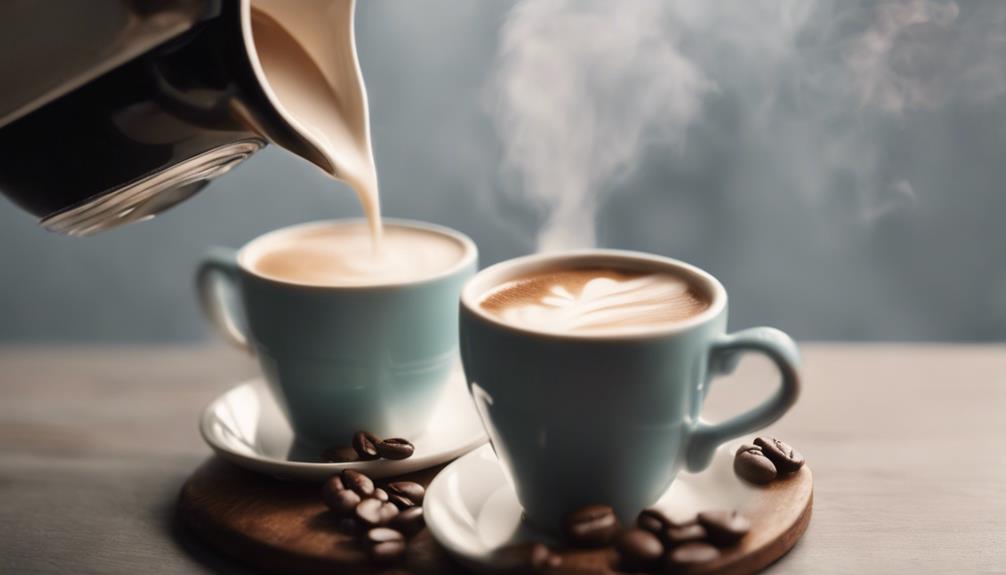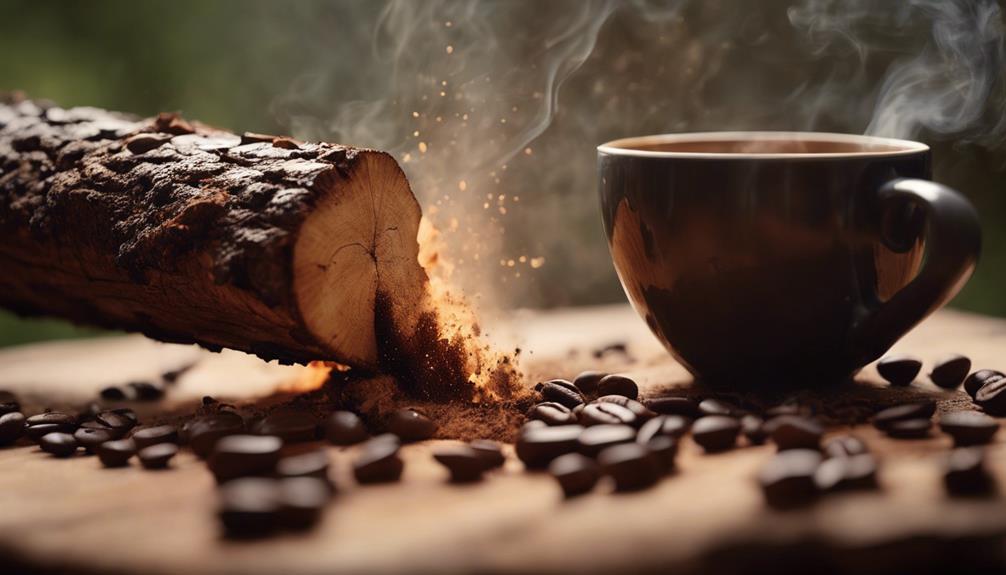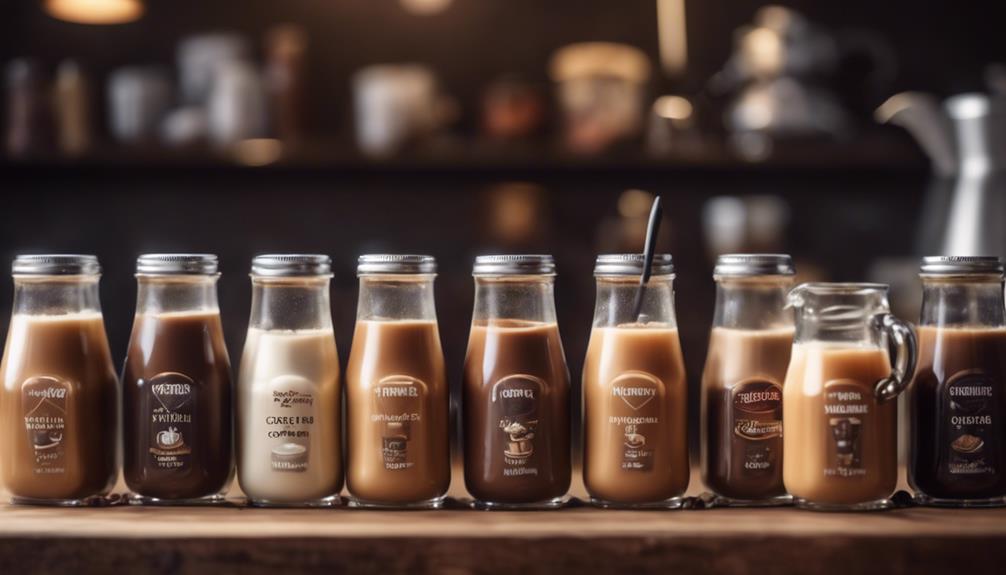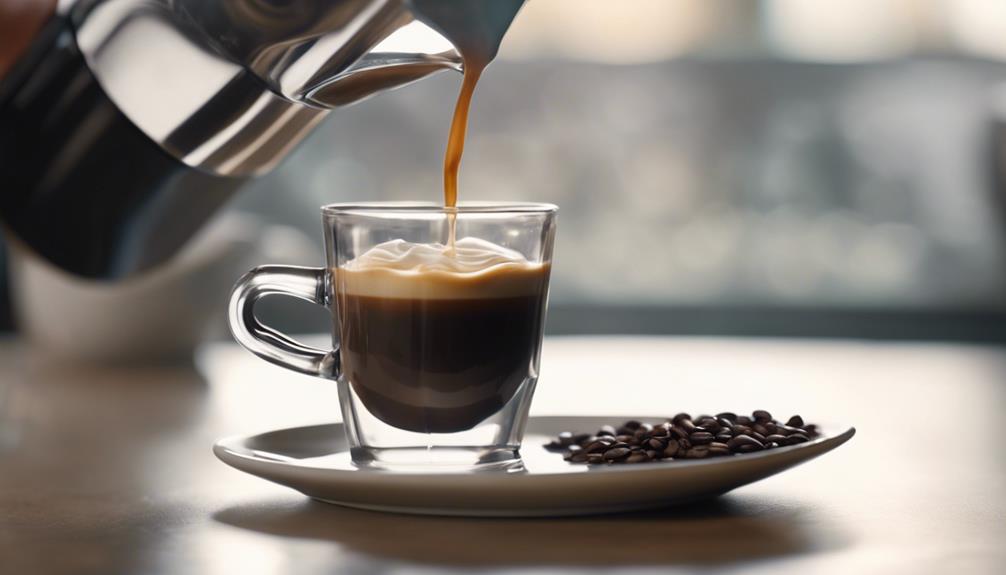When deciding between coffee creamer and heavy whipping cream, choose coffee creamer if you want to lower your calorie and fat intake, as it has less of both. Coffee creamer comes in a variety of flavors, including non-dairy options, and provides a smoother texture. On the contrary, heavy whipping cream is nutrient-dense but higher in fat. Take into account your dietary objectives and taste preferences when selecting which is best for your coffee. Being aware of these critical distinctions will assist you in picking the option that suits your health requirements.
Key Takeaways
- Coffee creamer is lower in calories and fat, making it better for calorie reduction.
- Heavy whipping cream is richer in essential nutrients like vitamins A, D, E, and K.
- Consider dietary preferences and health goals when choosing between the two.
- Heavy cream provides a richer, creamier texture, while coffee creamer offers a sweeter taste.
- Coffee creamer is convenient with various flavors, while heavy cream allows for customization.
Flavor Options of Coffee Creamer
In addition to that, when choosing coffee creamer over heavy whipping cream, you benefit from a diverse selection of flavors to elevate your coffee experience. Coffee creamer offers a wide range of options such as French Vanilla, Hazelnut, and Caramel Macchiato, adding a delightful twist to your daily brew.
Additionally, seasonal flavors like Pumpkin Spice, Peppermint Mocha, and Eggnog bring festive cheer to your cup during the holidays. For those with dietary restrictions, non-dairy options like almond milk, coconut milk, and oat milk provide a creamy alternative.
Moreover, sugar-free and low-calorie coffee creamer choices cater to individuals seeking to reduce their sugar intake while still enjoying a creamy coffee. By choosing coffee creamer, you can enjoy a variety of flavors and customize your coffee without the need for heavy whipping cream.
Explore the array of flavor options available to enhance your coffee experience with convenience and taste diversity.
Calorie and Fat Content Differences
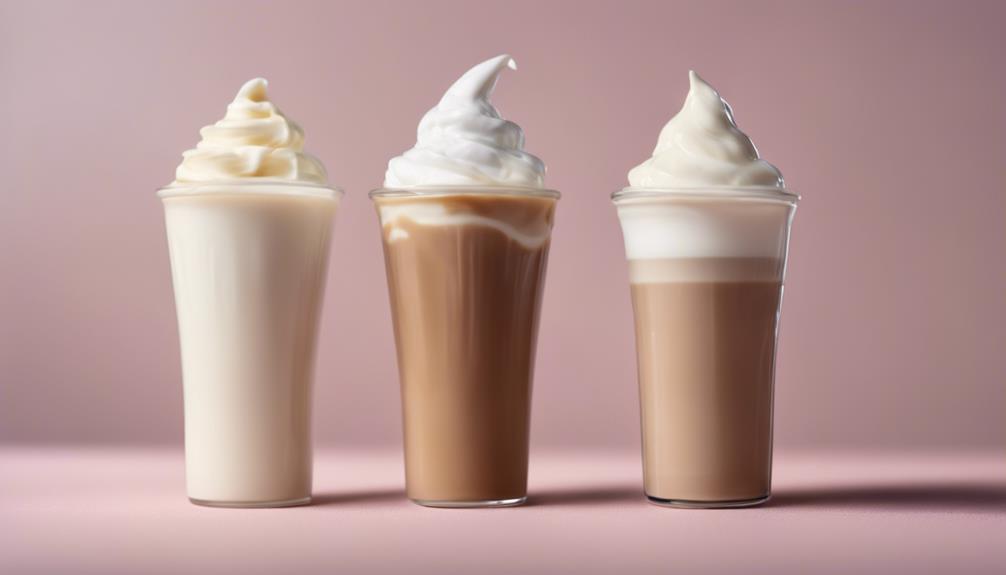
When comparing coffee creamer to heavy whipping cream, it's essential to note the significant differences in calorie and fat content. Heavy whipping cream contains a higher fat percentage and more calories per serving compared to most coffee creamers.
Understanding these distinctions can help you make informed choices based on your dietary preferences and health goals.
Calorie Comparison
Comparing the calorie and fat content between coffee creamer and heavy whipping cream reveals significant differences in nutritional values. Heavy whipping cream contains 51 calories and 5 grams of fat per tablespoon, making it higher in both calories and fat compared to coffee creamer. Opting for coffee creamer instead of heavy whipping cream can lead to a lower calorie intake due to the calorie disparity between the two options. Here is a comparison table highlighting the calorie and fat content variances between coffee creamer and heavy whipping cream:
| Nutrient | Heavy Whipping Cream | Coffee Creamer |
|---|---|---|
| Calories | 51 | Fewer |
| Fat (per tbsp) | 5g | Lower |
Consider these differences when choosing between coffee creamer and heavy whipping cream for your coffee. Making an informed decision based on the calorie and fat variations can contribute to a healthier dietary choice.
Fat Content Variance
To understand the differences in fat content between coffee creamer and heavy whipping cream, consider their varying levels of fat per serving. Heavy whipping cream contains about 36% fat, making it a rich and thick option.
On the other hand, coffee creamer typically ranges from 10-20% fat, offering a lighter alternative for your coffee. This variance results in coffee creamer having fewer calories compared to heavy cream. Opting for coffee creamer over heavy whipping cream can be a healthier choice, especially if you're mindful of your fat and calorie intake.
While heavy whipping cream provides a more decadent texture due to its higher fat content, coffee creamer delivers a lighter consistency with a milder taste. When deciding between the two, consider your dietary preferences and health goals to choose the option that best suits your needs.
Making an informed choice between heavy cream and coffee creamer can positively impact your overall health and well-being.
Creaminess and Texture Comparison
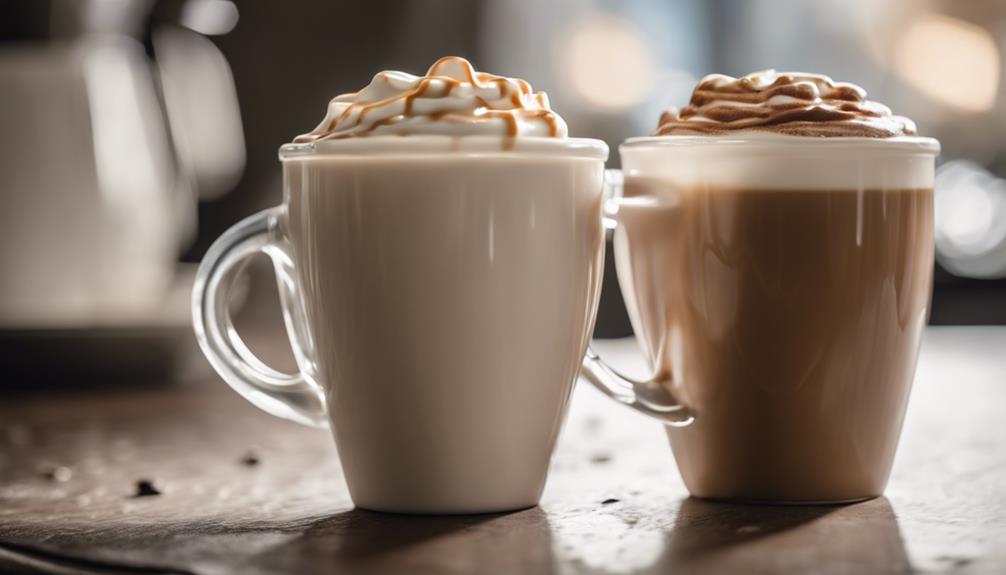
Coffee creamer provides a smoother and silkier texture in your coffee, while heavy whipping cream offers a richer and thicker consistency.
The creaminess of coffee creamer blends seamlessly, creating a creamy texture effortlessly, while heavy whipping cream might require more effort to fully incorporate.
Consider your preference for texture and creaminess when choosing between the two options for your perfect cup of coffee.
Creaminess Comparison
For a discerning palate seeking a velvety smooth texture in your coffee, considering the creaminess differences between coffee creamer and heavy whipping cream is essential. When comparing the two options, here are some key points to keep in mind:
- Coffee creamer typically offers a smoother and silkier texture compared to heavy whipping cream.
- Heavy whipping cream tends to provide a richer and thicker creaminess in coffee.
- Coffee creamer is often preferred for its light and airy feel in beverages.
- Heavy whipping cream contributes a velvety and indulgent texture to coffee drinks.
Understanding these distinctions can help you decide which option aligns best with your taste preferences.
Whether you lean towards the lightness of coffee creamer or the indulgence of heavy whipping cream, the choice ultimately boils down to your personal preference for creaminess and texture in your daily cup of coffee.
Texture Differences
When comparing coffee creamer and heavy whipping cream, you'll notice distinct differences in texture and creaminess. Heavy whipping cream offers a thicker, richer texture that provides a velvety and luxurious mouthfeel to your coffee.
In contrast, coffee creamer tends to be lighter and less creamy, lacking the same level of richness that heavy whipping cream delivers. The creamy texture of heavy whipping cream enhances the overall experience of your coffee, adding a layer of decadence that coffee creamer may not replicate.
If you enjoy a creamier and more indulgent cup of coffee, heavy whipping cream is the superior choice due to its ability to elevate the texture and richness of your drink. While coffee creamer serves its purpose as a convenient alternative, it may not provide the same level of creaminess and luxurious feel that heavy whipping cream can offer.
Ultimately, the texture differences between coffee creamer and heavy whipping cream play a significant role in enhancing your coffee-drinking experience.
Dietary Considerations for Creamer Vs. Whipping Cream
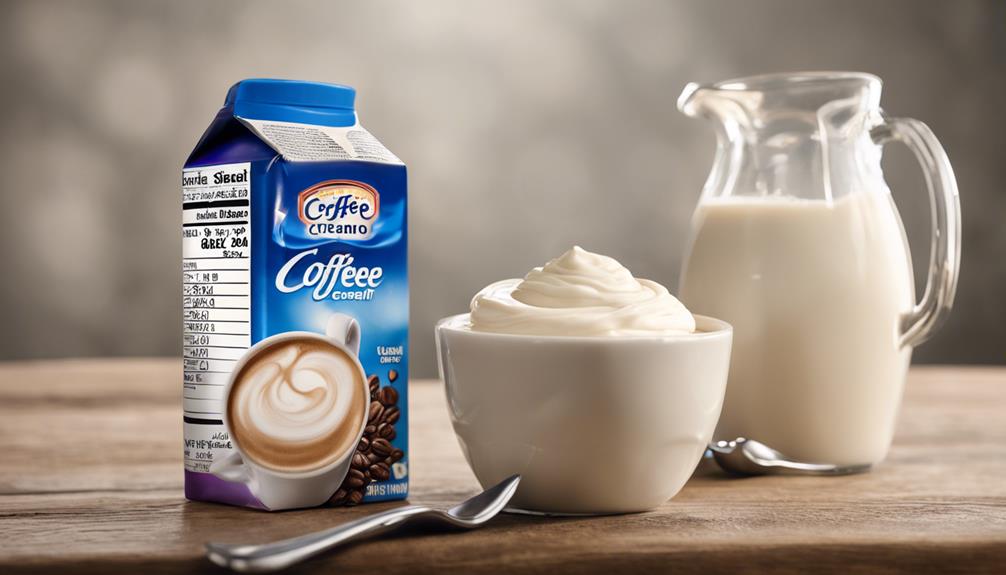
Choosing between creamer and heavy whipping cream involves considering the dietary implications of each option. When it comes to your health, here are some important factors to keep in mind:
- Coffee creamer: Lower in fat and calories compared to heavy whipping cream, making it a suitable choice for those monitoring their calorie intake.
- Heavy whipping cream: Higher in saturated fat content, which could potentially impact heart health if consumed excessively.
- Coffee creamer: Some varieties are non-dairy and lactose-free, catering to individuals with specific dietary restrictions or intolerances.
- Heavy whipping cream: Offers a rich and indulgent flavor, while coffee creamer provides a lighter, sweeter taste that may be preferred, especially in beverages like coffee.
Consider your calorie and fat intake goals when deciding between coffee creamer and heavy whipping cream, as this can play a significant role in your overall dietary choices.
Health Benefits of Each Option
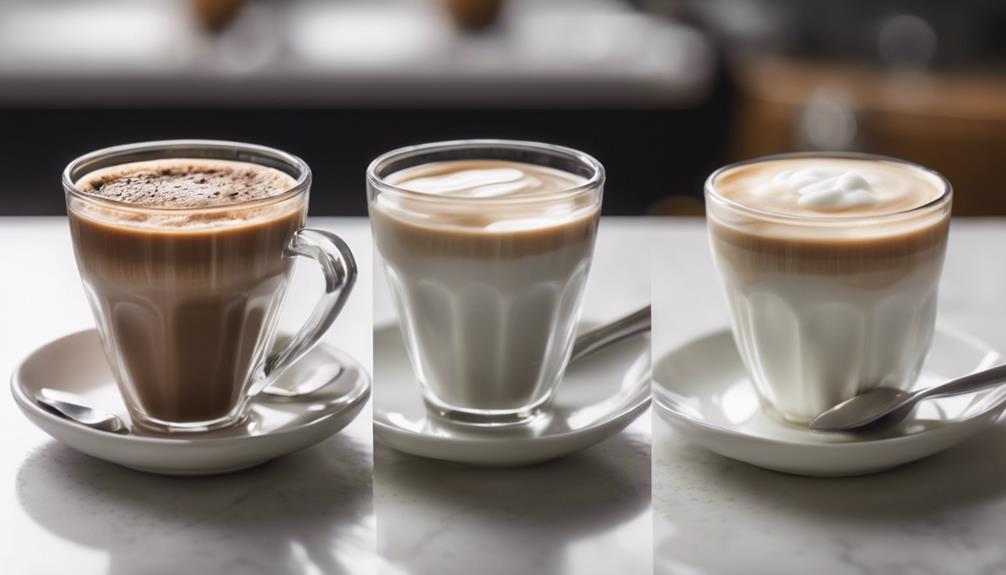
Consider the health benefits of each option when comparing coffee creamer to heavy whipping cream. Heavy whipping cream, despite being higher in calories and saturated fat, provides essential fat-soluble vitamins like A, D, E, and K, which may be lacking in coffee creamers. On the other hand, coffee creamers often contain added sugars and artificial flavors, offering more flavor variety and sweetness options. While heavy whipping cream is a more natural and less processed choice, coffee creamers can cater to different taste preferences.
| Heavy Whipping Cream | Coffee Creamers |
|---|---|
| Higher in calories and saturated fat | Often contains added sugars and artificial flavors |
| Rich in essential fat-soluble vitamins (A, D, E, K) | May lack essential nutrients present in heavy cream |
| Natural and less processed option | Offers more flavor variety and sweetness options |
When choosing between heavy whipping cream and coffee creamer, consider the nutrient content, flavor preferences, and overall health goals to make the best choice for your coffee routine.
Taste Preferences and Customization

To cater to your taste preferences and customize your coffee experience, consider the distinct flavor profiles offered by both heavy whipping cream and coffee creamer. Here are some key points to help you decide:
- Flavors: Heavy whipping cream allows for customization with flavors like vanilla or cinnamon, while coffee creamer comes in pre-flavored options such as hazelnut or caramel.
- Richness: Heavy whipping cream provides a rich and creamy texture, giving you control over the richness of your coffee, whereas coffee creamer offers a sweeter and flavored alternative.
- Control: If you prefer to adjust the richness of your coffee, heavy whipping cream gives you more control over the final taste.
- Sweetness: Coffee creamer adds sweetness to your coffee, making it a convenient choice for those who prefer a hint of sweetness without the need for additional sugar.
Consider these factors when choosing between heavy whipping cream and coffee creamer to tailor your coffee to your liking.
Convenience and Practicality in Use
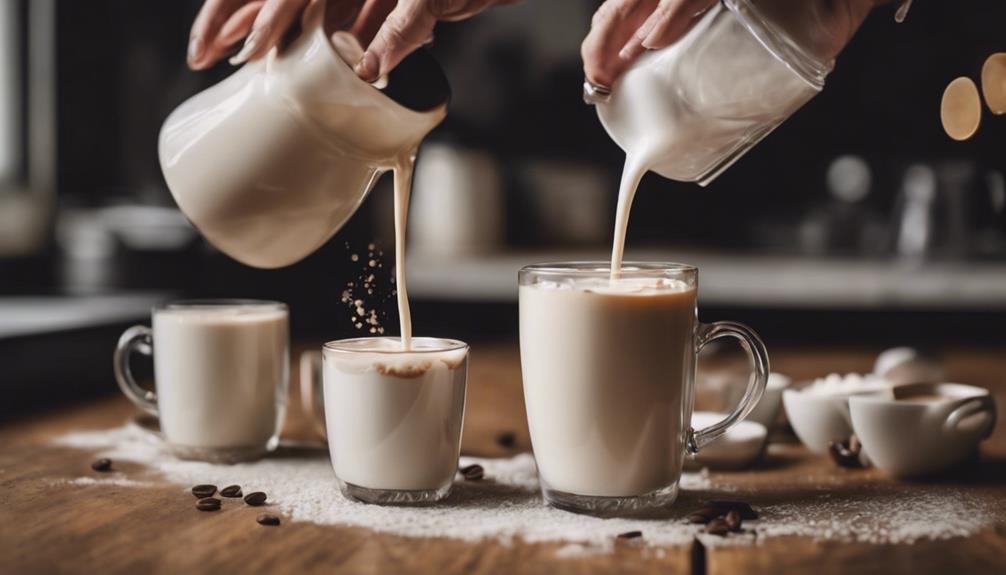
In addition to the convenience of using coffee creamer over heavy whipping cream for a hassle-free coffee experience, there are several other benefits to consider. Coffee creamer comes in single-serve cups or bottles, perfect for quick use on-the-go, while heavy whipping cream may require refrigeration and measuring.
The practicality of coffee creamer extends to its shelf-stable nature and pre-sweetened form, eliminating the need for additional sugar or refrigeration like heavy whipping cream. Additionally, coffee creamer offers a diverse range of flavors such as hazelnut, caramel, and mocha, enhancing the variety in your coffee choices without the hassle of measuring and storing heavy whipping cream.
With pre-portioned servings and easy accessibility, coffee creamer is a convenient alternative for those seeking a simple and efficient way to enjoy their coffee. So, when looking for a practical and convenient option for your coffee, coffee creamer stands out for its ease of use and versatility.
Overall Suitability in Coffee Applications
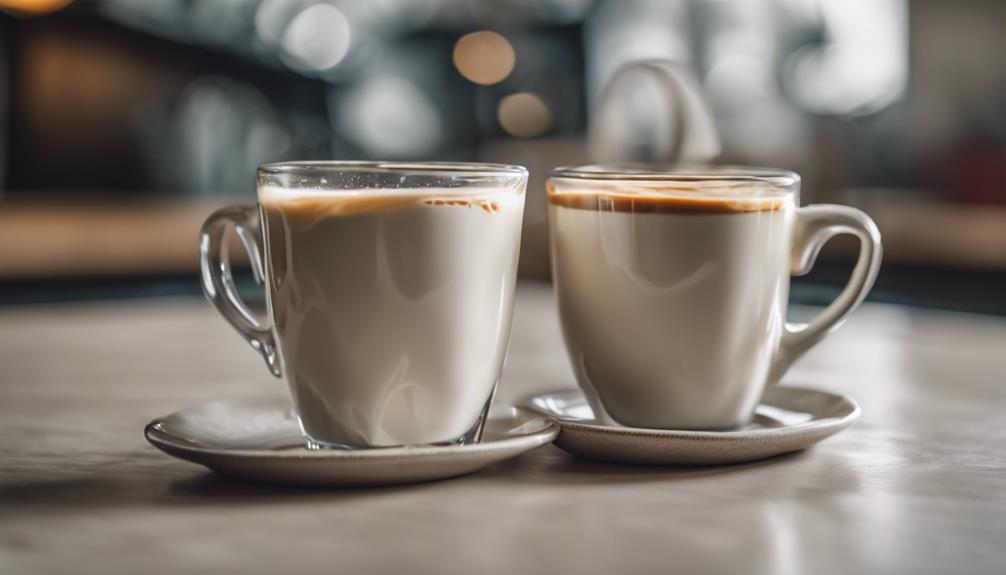
Coffee creamer and heavy whipping cream each bring unique qualities to your coffee, catering to different taste preferences and dietary needs. When considering their overall suitability in coffee applications, here are some key points to keep in mind:
- Coffee Creamer:
- Provides a sweeter taste compared to heavy whipping cream.
- Offers flavored options for added variety.
- Contains added sugars and artificial flavors for convenience.
- Ideal for those looking to sweeten their coffee effortlessly.
- Heavy Whipping Cream:
- Offers a richer and creamier texture than coffee creamer.
- Provides a decadent coffee experience for those seeking indulgence.
- Higher in fat and calories, which may not suit everyone's dietary preferences.
- Enhances the richness of coffee but may be less ideal for calorie-conscious individuals.
Both coffee creamer and heavy whipping cream can elevate the taste of your coffee, so choose based on your desired level of sweetness, richness, and flavor.
Frequently Asked Questions
Can I Use Coffee Creamer Instead of Heavy Whipping Cream?
You should consider personal taste and dietary preferences when choosing between coffee creamer and heavy whipping cream.
Coffee creamer is a milk substitute with added sugars and flavors, while heavy whipping cream offers a rich, creamy taste without additives.
If you prefer a richer and creamier texture in your coffee, heavy whipping cream may be the better choice. However, if you enjoy the convenience and flavor variety of coffee creamer, it can be a suitable alternative.
What Is the Best Substitute for Heavy Whipping Cream?
When seeking a substitute for heavy whipping cream, coffee creamer emerges as a popular choice. With its diverse flavors and lower fat content, coffee creamer offers a sweet alternative for your beverages.
While heavy cream provides richness, coffee creamer can bring a unique taste profile to your coffee. Consider your preferences and desired sweetness levels when opting for coffee creamer over heavy whipping cream, ensuring a tailored experience to suit your taste buds.
What Is a Healthy Substitute for Heavy Cream in Coffee?
When seeking a healthy substitute for heavy cream in coffee, consider almond milk's lower calorie and fat content. Coconut milk offers a creamy texture without high saturated fat. Oat milk provides a smooth consistency and added fiber. Cashew milk delivers essential vitamins and minerals. Soy milk is a good source of protein with lower fat.
These plant-based alternatives cater to various dietary preferences without compromising taste or texture in your coffee.
What Happens if You Put Heavy Whipping Cream in Coffee?
When you put heavy whipping cream in coffee, you introduce a velvety richness that can transform your morning routine. The high fat content creates a luxurious texture and intensifies the coffee's flavor profile.
However, be mindful of the increased calorie and fat content. Experiment with moderation to strike the perfect balance between decadence and health consciousness in your coffee intake.
Can Coffee Creamer Be Used as a Substitute for Heavy Whipping Cream in Recipes?
Yes, a milk frother with coffee creamer can be used as a substitute for heavy whipping cream in recipes. The frother will help blend the creamer into a smooth and creamy consistency, similar to heavy whipping cream. It’s a convenient alternative for those who prefer a non-dairy option in their recipes.
Conclusion
To sum up, while coffee creamer may offer a variety of flavors and lower calorie options, heavy whipping cream provides a richer, creamier texture and a higher fat content.
When considering taste, nutritional value, and overall coffee experience, heavy whipping cream is the superior choice.
Using coffee creamer instead of heavy whipping cream is like settling for a lukewarm cup of coffee when you could be savoring a perfectly brewed, steaming hot masterpiece.
Choose wisely for the ultimate coffee indulgence.
